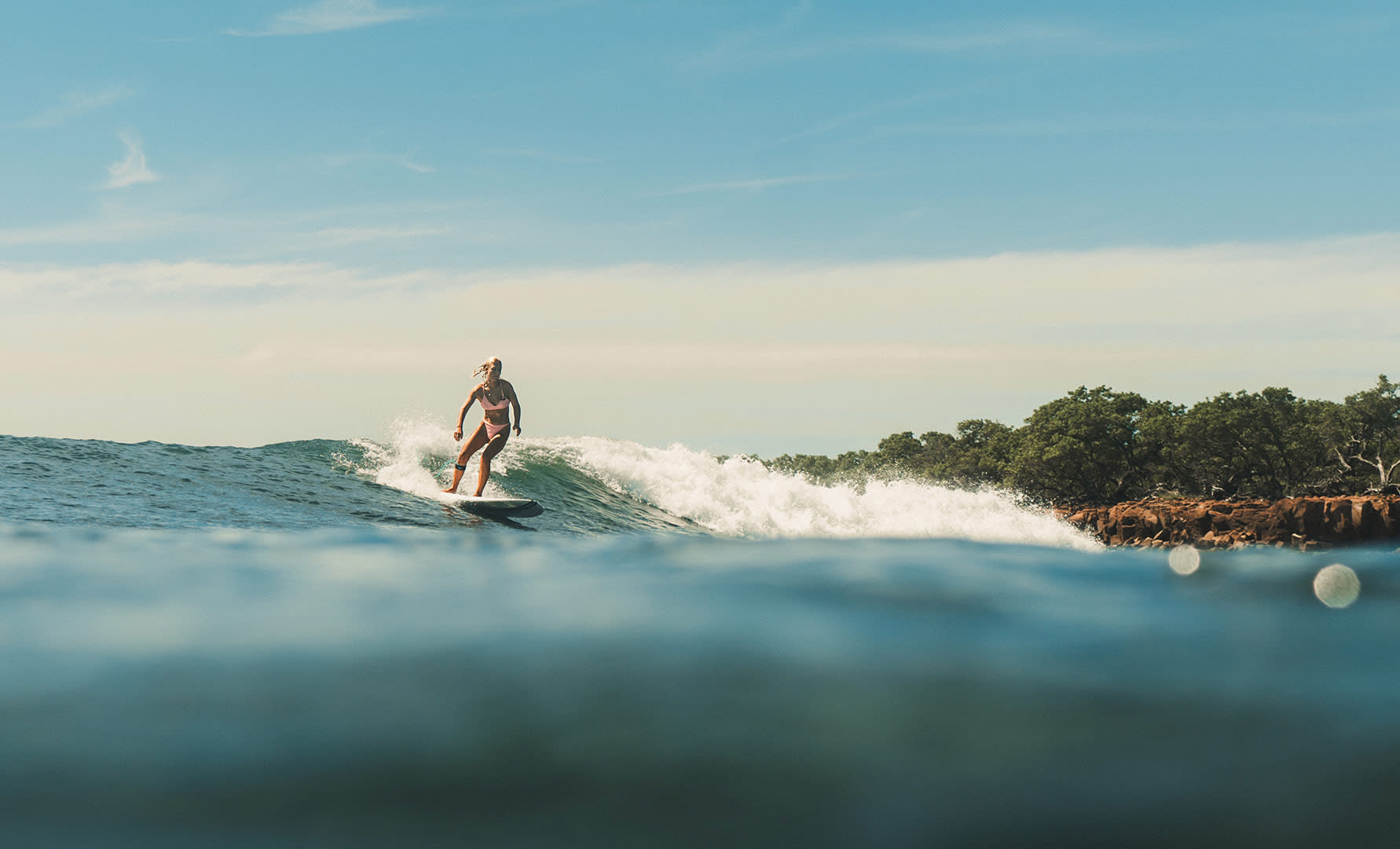
How to Read Surf Forecast & What Makes It a Great Day to Surf?
February 18, 2025Want to score the best waves on your next surf session? Learning how to read a surf forecast is the key! A surf report gives you the details on swell size, wind direction, tide, and wave period, helping you decide when and where to paddle out. We'll help you understand how to read Surfline's swell chart and what the "poor to fair" forecast means–this guide will break it all down. Mastering these surfing terms will help you catch more waves, improve your skills, and make every session count!
What makes a great day to surf? Well, it depends. Some people will be happy no matter the conditions, but for those who want more than just water and waves, there are some key indicators to watch out for.
You should know the surf conditions before you go out on your own, and a great way to do that is by reading a surf report. The time and place can change, depending on what kind of surf report there is. Surfing is fun but it can always be better with a little dose of planning when and where to surf beforehand. Let’s find out how to read surf forecast!
How to read a surf report
Reading a surf report can be confusing at first for beginners. Today, we will explain the key elements and how you can gauge when an epic swell is coming your way after reading this article.
A “good” swell size, or surf conditions in general, will depend on several factors such as if it’s a sand- or reef-break, wind- or storm-swells and many more things. However, learning to read these numbers is a great first step on your way to improving your surfing learning curve.
Key factors of reading surf forecasts are:
Swell size
The size of the wave, or swell height, is a measure in feet or meters.
If the surf forecast says 1-3m (3-9ft), then it's usually a good time to go surfing. 3m waves are not appropriate for beginners, but experienced surfers take on waves of incredible height. Under 1 meter, waves are usually more suited to beginner surfers.
Swell period
The swell period is measured in seconds. At least 8 seconds of waves and longer for the swell to build momentum is essential in most places. The duration of these waves can be gauged by looking at how far the wave is breaking out beyond the curl or inside on tube sections.
When waves are breaking at a 6-second interval, surfers will find the waves weak and unappealing.
RELATED: Not sure what some words mean? Read our guide on 41 surfer lingo & terms and get back here right after!
Swell direction
Swell direction tells you where the swell is coming from in degrees/bearing. That will depend on the local beach. Learn to know your break, and weather reports from other beaches can provide helpful info for how conditions might be elsewhere.
Understanding the wind direction and swell size can help you know which areas you will find the biggest waves. If your beach is northeast facing, it will miss out on many swells that come from the south. When the swell is 5m from the south and east-northeast facing the beach, it might be a better choice.
Wind direction
Surf forecasts often display wind direction in degrees/bearing. Surfing is usually best when it’s wind-free. A surfer values glassy conditions―a calm surface of the water without gusts of wind―the most, but tough surfers learn to manage even the worst conditions.
In surfing, there are two primary wind conditions: onshore and offshore:
Offshore winds, which push waves towards the coast rather than away from it, are ideal for surfing.
Surfers who want to practice aerial manoeuvrers would most likely prefer catching an onshore wind.
Wind strength/speed
The lower the number, the more likely a wave will be good. At speeds below five kilometres per hour (3mph), the ocean will be great regardless of whether you're going in a direction or not.
When winds are over 30km/h (20mph), it will get complicated. Even when they come from off the shore. The morning is often the best time to surf because there are fewer winds.
Tide
Tides are highly specific to an individual's local break, so you'll need to learn how tide patterns affect your particular spot.
What are the best surf forecast apps?

The best apps for surfers are WindGuru and Surfline.
While it's difficult to predict what the wind will do in your area exactly, you can trust WindGuru for a general idea of how things are going. Whenever there is an eventful weather pattern happening on its radar maps, they tend to be accurate and helpful.
The Surfline app allows users to access worldwide weather information about breaking waves from hundreds of beaches around the globe. People can get information about the waves and what kind of weather there might be in the future. They can learn this by watching a local beach cam or looking at a more detailed map with more information about different places.
How to read Surfline's surf forecast
Surfline uses Surf Quality metrics to provide its reports.
The ratings in the surf forecast will range from low to high. It is a mix of all the different conditions that affect how good and easy it is to surf.
Different conditions can affect the waves. For instance, there might be wind and a calm ocean surface. Or there might be a different wave shape, and the tide might also affect it.
Advanced surfers might have a higher opinion of the waves than other surfers. So if an average surfer thinks that a wave is GOOD, an advanced surfer might think it's only FAIR. But even if a beginner surfer believes that a wave is GOOD, for them, it might be POOR because they can't handle it.
Surfline's surf quality scale
- 1 = FLAT: No waves mean no surfing.
- 2 = VERY POOR: The forecast may include words like "lack of surf," "bad," or even "very stormy."
- 3 = POOR: Due to wind and a poor tide, there are only some fair waves to surf this morning.
- 4 = POOR to FAIR: Low to average waves.
- 5 = FAIR: Waves are average in size, with most (70%) waves being rideable.
- 6 = FAIR to GOOD: Conditions are mixed with fair surf and some waves that could become more desirable for advanced surfers (30% GOOD).
- 7 = GOOD: The waves are (50%) good at the moment.
- 8 = VERY GOOD: With most waves (70%) being of GOOD quality, beginners and less-seasoned surfers are sure to have a blast.
- 9 = GOOD to EPIC: Highly favourable wave quality with a chance for excellent waves.
- 10 = EPIC: The conditions are excellent for surfing, with most (70%) waves reaching epic and outstanding surf requirements.
Need help choosing where to go on your next surf trip? Try out our article on the Best Places To Learn How To Surf. It’s a delightful read that will get you inspired to book your next surf trip right away!
NEWSLETTER
Stay up to date, sign up for our newsletter

Maren Gimnes
Maren is a copywriter and content creator with a true passion for exploring the beautiful planet we call home. Her love for the ocean and salty days brought her to Lapoint, where she’s been living the digital nomad life and visiting our surf camps in all corners of the world. Maren aims to inspire others to pursue the surf lifestyle, to never miss a sunset and to follow their dreams.

